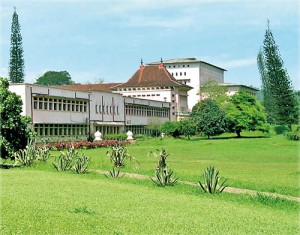A university is born: From concept to physical establishment
View(s):My observation about the five volume compilation on the founding of the University of Peradeniya is that the compiler A.T. Alwis, former Senior Assistant Librarian of the University of Peradeniya has made a valuable contribution by collecting, arranging and presenting these documents in a methodological order.
These five volumes provide a detailed picture of the events and deliberations leading to the establishment of the University of Ceylon at Peradeniya. Those who were engaged in this pursuit took a considerable time for their deliberations and the final decision making was not an easy task. It led to controversy and much debate. One such contentious issue was the choice of a suitable site for the University, one group favouring a site in Colombo and the other a site in Kandy.
In addition there were a number of personalities identified with the proposal for a University who contributed immensely in the development of the idea of establishing the University as well as in determining its exact nature. For instance, the idea of a residential University and the faculties to be established were some of the issues which led to long drawn-out discussions and debate. All these developments have been sufficiently covered in Mr. Alwis’s compilation of five volumes. The publication will be extremely valuable as a source book for future researchers undertaking research on this particular subject.
Apart from this specific thematic value of the compilation there is yet another aspect which deserves commendation when we assess the value of this work. The documents dealt within the work are very much relevant in the study of nationalism in Sri Lanka as it operated during this crucial period of Sri Lanka’s history in the transition of power from the British rulers to Sri Lankans. In addition the publication is also relevant for the study of the constitutional developments of Sri Lanka since this period is considered to be one of the formative years of Sri Lanka’s experiment with representative and responsible government. The fact that the contents of these volumes cover the contribution of a number of political figures is another notable feature of this publication.
In these volumes the compiler has tried to relate the history of the conceptual beginnings of the establishment of a University and its actual physical establishment at Peradeniya covering a history of over 50 years up to 1954. As the compiler recalls the task proved to be a difficult one. For one thing, the records were not as complete as one would have wished. For another, collecting the necessary material from various archives, such as minutes of meetings of committees and other bodies, Hansards, annual reports, convocation addresses, University calendars, other memoranda and files of correspondence, and archives deposits was not an easy task. However he has had the confidence to embark on this monumental task. His familiarity with the university system had made his task somewhat lighter in spite of its colossal nature. He did this at his own initiative without any financial or other support and it would have given him a free hand in selecting and presenting the material in the five volumes in his own way, and I think that it had paid dividends as proved by the quality and standard that he has been able to maintain throughout.
The arrangement of this work in five volumes is as follows:
Vol. 1: The documents of agitations, beginning year 1906, for a University by a group of personalities led by Sir Ponnambalam Ramanathan.
Biographical sketches of the founder members, the benefactors, the first Deans of the Faculties, the Architects, and the high ranking authorities of the Government of Ceylon, involved in the Peradeniya University Scheme.
Architectural aspects of the University, including the architectural sketches released to the press by the Minister of Public Works.
Sir Ivor Jennings’ papers, published in the local newspapers, magazines. Also included an unpublished document of his 10 year master plan of the Peradeniya scheme.
Visit of the Duke of Gloucester in connection with the laying of the foundation stone for the University.
Opening of the University.
Establishment of Sangarama for the Buddhist monks.
Comments of controversies relating to the University site, published in newspapers.
Vol. 2: Akbar Report, a Report of the University Site Committee (1927).
Riddell Commission Report, a Report of the University Commission (1929).
The Ceylon University Ordinance No. 20 of 1942.
Proceedings of the Bonjean Hall Meeting, Monday, June 6, 1927.
Vols. 3-4: Proceedings of the Legislative Council of Ceylon (1924-1931); the State Council of Ceylon (1932-1947); and the Parliament of Ceylon (1948-55) on the University Site and the construction work.
Vol. 5: Unpublished Correspondence.
Annual Reports of the Council of the University of Ceylon, and the Administration Reports- Public Works Department relating to the Peradeniya University Scheme.
The book is available at the Deputy Vice Chancellor’s Office, University of Peradeniya.
For inquiries please call: 081-2389140,
(The reviewer is a retired Professor of History, University of Peradeniya)
Book facts
Peradeniya: the Founding of a University (In 5 Volumes) Compiled by A.T. Alwis. Published by the University of Peradeniya Press, 2013. Price: Rs. 8,000 (The complete set). Reviewed by Dr. Thilaka Meththananda


